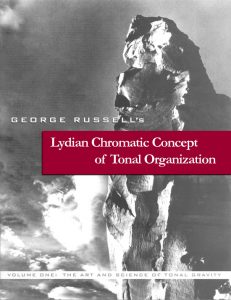Index to posts in this series
- The Lydian Chromatic Concept of Tonal Organization – Part 1
(Introduction) - The Lydian Chromatic Concept of Tonal Organization – Part 2
(Theoretical Foundation) - The Lydian Chromatic Concept of Tonal Organization – Part 3
(The Seven Principle Scales) - The Lydian Chromatic Concept of Tonal Organization – Part 4
(The Four Horizontal Scales) - The Lydian Chromatic Concept of Tonal Organization – Part 5
(Differences Between Horizontal and Vertical Scales) - The Lydian Chromatic Concept of Tonal Organization – Part 6
(Chordmodes, Principle Chordmodes and Principle Chord Families)
Introduction
 This post is the first in a series covering the “Lydian Chromatic Concept of Tonal Organization”, a jazz theory book written by George Russell in 1953. The “Lydian Chromatic Concept” (LCC for short) is a novel approach to music that treats the Lydian mode as the primary mode rather than Ionian (the major scale).
This post is the first in a series covering the “Lydian Chromatic Concept of Tonal Organization”, a jazz theory book written by George Russell in 1953. The “Lydian Chromatic Concept” (LCC for short) is a novel approach to music that treats the Lydian mode as the primary mode rather than Ionian (the major scale).
Russell’s idea is actually based on some very compelling observations but his book is rather dense and difficult to get to grips with. I intend the posts in this series to deal with some of the core concepts presented by Russell but in a more straightforward and accessible way – a way that I can understand! I’m certainly no expert and this will be a learning process for me too.
For a general overview of the “Lydian Chromatic Concept of Tonal Organization” try this article on Wikipedia. Further information can be found at lydianchromaticconcept.com, which has information about Russell and which appears to be selling the book at the bargain price of $125.00. The book is hard to find, at least at reasonable prices (for example check out this used book site).
George Russell
Wikipedia comes to the rescue again for basic biographical information about George Russell but if you want to see the man in action and hear some of his work the following YouTube video is a great place to start. It includes one of my favourite Russell compositions, the fabulously named “Stratus Phunk”.
Although George Russell is not particularly well known now he was a huge influence on players like Miles Davis. In fact the video above features the incomparable Bill Evans, a close associate of Russell, on piano. It is not often acknowledged how much the modal movement in jazz – so often attributed to players like Miles Davis – owed to Russell’s ideas.
Stay tuned for further posts on the LCC. I’ll keep the index at the top of this post updated as I add new ones.

OMG thanks a lot!!!!
The Lydian scale (as regards the concept) is not a mode. George Russell would not agree with your description – and to quote such an unreliable source as Wikipedia as a go to place for information is crazy.
Hi Andrew. Thanks for the comment. As I state above “I’m certainly no expert and this will be a learning process for me too” so any constructive criticism is welcomed. I would say however that to the non-Russell fundamentalist lay person coming to the LCC with a major scale theory background and who is trying to sum up the LCC in a few words the LCC does kinda treat what – in major scale theory terms – is the Lydian mode as the starting point. But I agree, Russell does refer to the Lydian Scale, not mode. As for the… Read more »